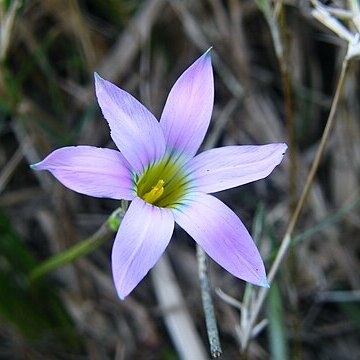Plants 100-350(-600) mm long. Corm with a crescent-shaped basal ridge. Stem 10-100(-300) mm long. Basal leaves 1.2 or more, filiform, or compressed cylindrical, 100-350(-600) x 1-2 mm, grooves narrow. Inner bract greenish or reddish, with brown-spotted or brown-edged membranous margins. Flowers 15-35 mm long; lavender-blue or sometimes white or bluish-mauve, in the lower half orange or golden yellow, often with a pale transverse band in the throat, outer segments on the backs irregularly marked in green and brown. Perianth tube 3-5 mm long; segments narrowly elliptical, 10-28 x 3-7 mm, obtuse or subobtuse. Filaments 3-6 mm; anthers 3-6 mm, yellow. Style 8-13 mm; stigmas at or above the anther tips. Capsules shortly cylindrical, on curved peduncles which straighten later.
Cormous geophyte, up to 100 mm tall, corm with a crescent-shaped basal ridge, stem branching above the ground. Basal leaves 1 or 2, narrowly 4-grooved. Flowers white (or mostly pale blue elsewhere), with a yellow cup, sometimes fragrant; outer bract green, inner bract hyaline with a narrow green or red keel.
Cormous geophyte to 10 cm, corm with an oblique basal ridge, basal ridge fibrous, stem branching above ground. Basal leaves 1 or 2. Flowers blue to white with yellow cup, often blotched on reverse, sometimes fragrant, inner bracts membranous.

